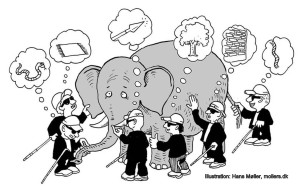Mind Map for 25 Feb: http://popplet.com/app/#/1571354
Story telling — long has this been a means of relaying vital cultural history and identity, as well as serving as the first-ever training regimen for molding the minds of young and old alike. But it’s clearly more than that: it’s reflective assessment incarnate. What better way to find out if your young padawans have absorbed the enormity of the Powers of the Force than to ask them to repackage the learning — the connections, the network nodes, the relationship movements, the buses, etc.?
So it would only be natural to replicate such learning practices in a classroom of
our sort, and certainly gave me new ideas for my own freshman writing courses! Networking our thinking, making visible the connections between course objectives & practices, revealing some of the borders and boundaries in new ways — all mediated by a specified space and time, creating a framework for our thinking that both limited it and gave it new range. Yep — pedagogy, Yoda-style. And, just like me / us, Luke is the older padawan — with all sorts of other networked connections from life and learning forcing their way into his training, distracting but also proving to be unexpected paths of action. Say hello to Yoda meets Actor Network Theory.
Google Images’ available image selections for networks is becoming increasingly less accurate in their potential to capture the types of connections we’re making. Many results reflect a dominance of either machine or organic, but not a mix of both. I think that’s telling, at least insofar as the thinking I’m doing about mediators (thanks Latour).
 ALERT: Personal “Aha!” moment — (better late than never) Some of my thinking has been whether or not we can start to think about THEORIES as GENRES, and if so, can we than apply genre tracing as a way to map the conflicts and the tensions — as this week’s reading of Spinuzzi suggests we do — in order to place them in a map that shows the productive relationships available to our continued work? Hello Popplets and Legos and Storytelling! I realize that Spinuzzi likely intended genre tracing to be applied to nodes or objects of study, but isn’t that exactly what we are doing with our activities?
ALERT: Personal “Aha!” moment — (better late than never) Some of my thinking has been whether or not we can start to think about THEORIES as GENRES, and if so, can we than apply genre tracing as a way to map the conflicts and the tensions — as this week’s reading of Spinuzzi suggests we do — in order to place them in a map that shows the productive relationships available to our continued work? Hello Popplets and Legos and Storytelling! I realize that Spinuzzi likely intended genre tracing to be applied to nodes or objects of study, but isn’t that exactly what we are doing with our activities?
While completing my Mind Map, I came across an interesting article of applied theory that reminded me of our Latour reading this week: “Spotting Boundary Spanner.” The article asserts that “Boundary spanners are a vital missing component in connecting practical theories and knowledge with real world applications.” Latour has asserted that this spanner / mediator is likely a person.
So I ask you: are WE padawan spanners? Learning the way of our disciplines (The Force) to mediate “all the theories.” By George, I think I may be onto something.





